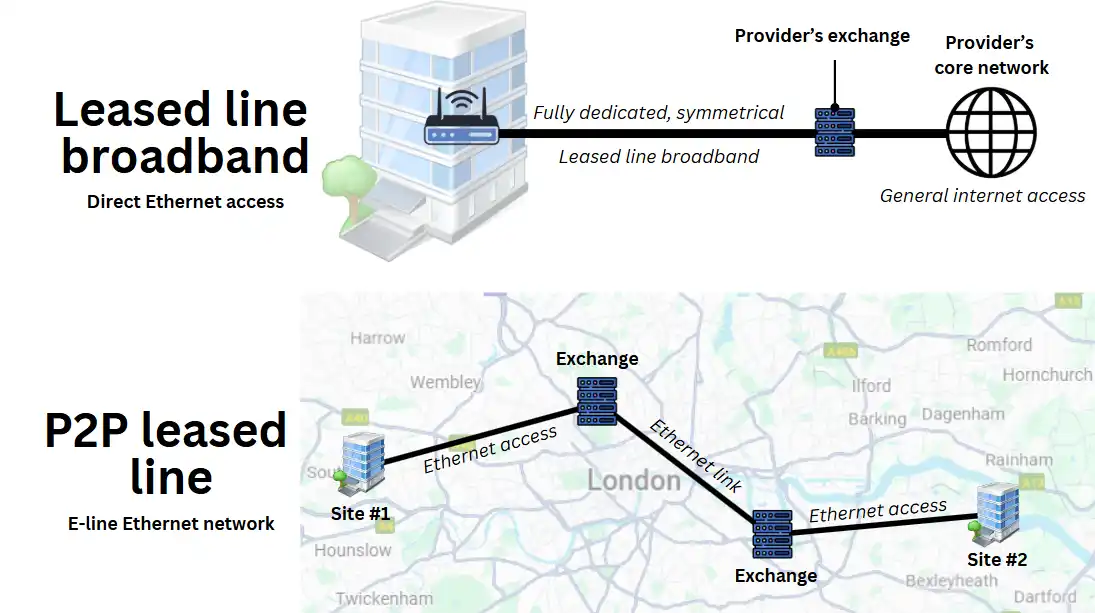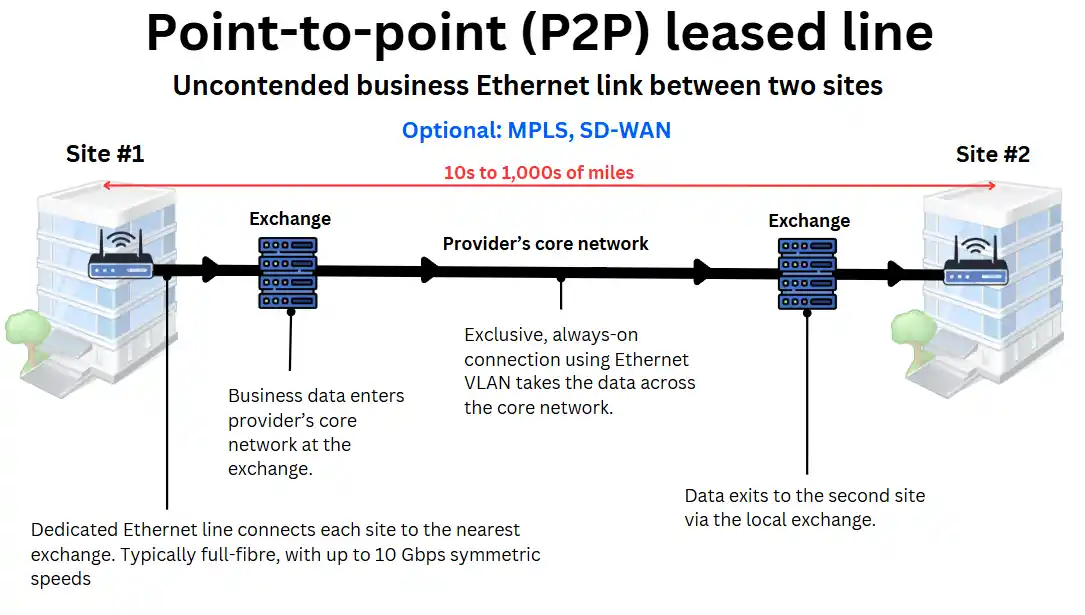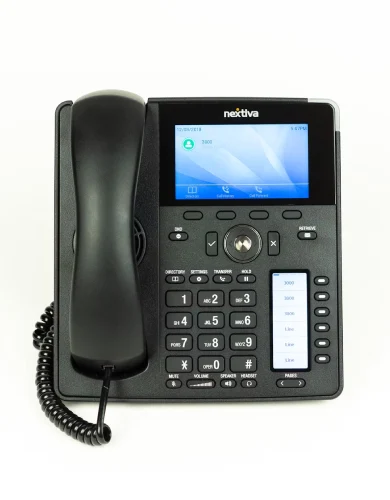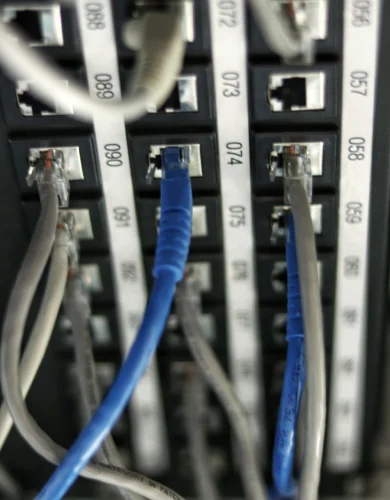Point-to-point leased line
A point-to-point (P2P) leased line is a private, high-speed connection between two business sites, perfect for secure, reliable data transfer that avoids the public internet. This article explains how P2P leased lines work, how they are installed and cost, and why it’s the gold standard for site-to-site connectivity.
Contents:
- Point-to-point leased line vs leased line broadband
- How does a point-to-point leased line work?
- P2P leased line installation
- Key features of a P2P leased line
- P2P leased line costs
- P2P leased lines vs other point-to-point networks
- P2P leased line providers
Point-to-point leased line vs leased line broadband

A point-to-point (P2P) leased line connects two business sites with a dedicated, symmetrical, SLA-backed Ethernet link designed specifically for routing data between those locations.
This private link operates independently of either site’s internet connection and is commonly used to connect offices, data centres, warehouses, labs, hospitals, and universities.
By contrast, leased line broadband delivers business-grade internet access to a single site, while offering the same benefits (dedicated bandwidth, symmetrical speeds, and robust SLAs) but for general internet use rather than site-to-site connectivity.
The key distinction is that a P2P leased line is a business networking solution, while leased line broadband is a business internet solution. Both can be used simultaneously via a multi-WAN business broadband router.
Because both services are Ethernet-based, a standard leased line can be upgraded into a P2P access point (and vice versa) with minimal disruption.
The table below summarises the key differences:
| Feature | P2P Leased Line | Leased Line Broadband |
|---|---|---|
| Connectivity | Private, uncontended site-to-site communication | Internet connectivity for a single site |
| Internet access | No (unless routed through another site or a separate broadband connection) | Yes (direct internet access) |
| Use cases | Office interlinking, data centre sync, internal systems | Everyday business connectivity, cloud apps, cloud VoIP, email, etc |
| Bandwidth | Dedicated, symmetrical | Dedicated, symmetrical |
| Service Level Agreements | Yes | Yes |
| Ethernet compatibility | Yes | Yes |
How does a point-to-point leased line work?
A point-to-point (P2P) leased line is a dedicated, high-speed link between two business sites across town, country, or even internationally. It provides consistent, symmetrical bandwidth and is commonly used when businesses require a reliable, private data path for critical applications like business VoIP phone systems.
Here’s how this high-performance business connection works:

1. Premises-to-exchange link
A dedicated Ethernet access line is installed at each location between your premises and the nearest provider exchange, also known as a Point of Presence (PoP).
This line connects your local area network (LAN) with the provider’s long-distance core network, much like private roads linking your sites to the motorway.
In most cases, the Ethernet access line is a full fibre leased line broadband connection adapted to function exclusively for site-to-site communication to ensure the highest level of performance and privacy.
In rural or underserved areas where fibre is unavailable, Ethernet-in-the-First-Mile (EFM) connections using bonded copper cables can be used for Ethernet access, albeit with lower speeds and reliability.
To keep the Ethernet line fully dedicated to inter-site communication, a separate broadband connection is typically installed at each location for general internet access.
In some setups, a smaller site may route its internet traffic through the larger site via the P2P leased line, enabling a centralised security and network management model (i.e. hub-and-spoke).
2. Exchange-to-exchange link
At the exchange, your business data enters the provider’s long-distance core network to travel to the other site’s local exchange. This low latency backbone carries data for thousands of subscribers nationwide, like the internet equivalent of a motorway network.
To preserve the dedicated performance and privacy of a P2P leased line, a virtual link is created between each exchange using an Ethernet VLAN (Virtual Local Area Network).
This ensures that a reserved portion of the backbone’s bandwidth is exclusively dedicated to your site-to-site traffic, enabling providers to offer performance guarantees, even across hundreds of miles.
This bandwidth allocation mirrors the capacity of each site’s Ethernet access line, ensuring consistent performance across the entire route.
Ideally, both sites fall within your provider’s core network coverage. If not, providers often collaborate with partner carriers to extend connectivity, particularly for national or international P2P leased line links.
3. Ethernet network formation
A P2P leased line is created by integrating the site-to-exchange and exchange-to-exchange segments into a single, unified connection, also known as a Business Ethernet network.
This is made possible by building the entire route using Ethernet-compatible technologies: MPLS-over-Ethernet in the provider’s backbone, and Ethernet-over-fibre for the last mile between the exchange and your premises.
Your provider manages the entire P2P leased line centrally. It can disable the link instantly as part of a cybersecurity response, or scale bandwidth up or down in line with changes to your contract.
Additionally, new Ethernet-based links can be added with ease, enabling your network to scale into a point-to-multi point, or even a multipoint-to-multipoint mesh network.
4. MPLS and SD-WAN integrations
In addition to their site-to-site connection, many businesses integrate their P2P leased lines into their existing MPLS, SD-WAN or persistent VPN networks to reduce latency, optimise routing and enhance security through encryption.
Each of these technologies adds a different layer of control and performance:
- MPLS is a data prioritisation system that reduces latency and congestion.
- SD-WAN is a cloud routing optimiser that dynamically selects the best paths for different data and encrypts it.
- Site-to-site VPNs form private, encrypted tunnels between fixed locations.
P2P leased line installation
A P2P leased line installation involves several key steps, with the total lead time ranging from two weeks to several months. Timelines depend primarily on how complex the Ethernet access installation is at each site.
Once the physical connections are in place, your provider will configure the link to operate as a single, unified connection between locations in line with the Service Level Agreement (SLA).
Here’s the breakdown:
1. Installing leased line broadband at each site
Typical duration: 1 to 3 months
This is usually the longest part of the process. It involves establishing dedicated fibre optic connections from each premises to the nearest network exchange.
Depending on the site’s location and existing infrastructure, this may require site surveys, duct access, road digging or even civil engineering works.
In urban areas, the use of existing fibre routes and ducts significantly reduces installation times, but in more remote or underserved areas, new infrastructure usually need to be built.
Where fibre isn’t feasible, Ethernet-in-the-First-Mile (EFM) over bonded copper lines can be used as an alternative for Ethernet access, though with reduced performance.
This step ends after the provider tests and validates the Ethernet access.
For more information, visit our guide to leased line installations.
2. Configuring the P2P leased line
Typical duration: 1 to 2 weeks
With both broadband connections in place, your provider will configure their network to create a dedicated, virtual link between the two sites.
This step involves setting up routers, creating VLANs, adapting MPLS paths, and ensuring the connection is uncontended, symmetrical, and resilient.
Configuration times can vary depending on the provider’s systems and the scale of the network, with international or multi-site setups taking longer.
Secondary redundant connections can be deployed for businesses requiring high availability to provide P2P leased line failover. This ensures continuous connectivity in case of hardware failure or other disruptions.
This step ends after the provider tests and validates the full P2P leased line connection.
3. Integrating with existing MPLS, SD-WAN or VPNs
Typical duration: 1 to 2 weeks
This integration is usually handled by a Managed Service Provider (MSP) or your IT team in conjunction with the business broadband provider.
This step is typically straightforward if planned in advance and with the right hardware already in place. However, if additional equipment or reconfiguration is required, it may take longer.
The integration phase is complete once the provider has validated seamless operation between the P2P leased line and the wider business network.
Key features of a P2P leased line
P2P leased lines are designed to provide the most reliable and efficient site-to-site communication. Here are their key features:
Uncontended bandwidth & symmetrical speeds
P2P leased lines deliver dedicated, fixed-capacity bandwidth unaffected by network congestion, meaning no bandwidth throttling, even during peak times. Bandwidth is symmetrical, so upload and download speeds are identical.
This consistency is critical for real-time applications, large file transfers, and other latency-sensitive tasks central to business operations.
Low latency
P2P leased lines offer low latency compared to traditional broadband, making them ideal for real-time applications like remote VoIP, video conferencing, and cloud-based services.
Latency levels depend on the type of Ethernet access used. Full fibre connections offer the lowest latency, while copper-based Ethernet-in-the-First-Mile (EFM) introduces slightly higher delay.
Long-distance connections
Thanks to its reliance on globally standardised Ethernet technology, a P2P leased line can span across towns, regions, or even international borders. As long as both sites are within your provider’s network coverage area, distance is not a limiting factor.
Service Level Agreements
P2P leased lines come with robust SLAs that typically guarantee 99.9% uptime, sub-5ms latency for domestic links, and minimal packet loss.
Service quality can be further enhanced with optional features such as leased line failover and network load balancing.
Scalable bandwidth and network size
Built on Ethernet protocols, P2P leased lines are inherently scalable. Bandwidth can be increased or decreased by your provider with minimal disruption and no on-site engineering, and new links can easily be incorporated to increase the size and complexity of your business network.
Compatibility with MPLS, SD-WAN, and VPN
P2P leased lines provide an ideal foundation for overlay technologies like MPLS, SD-WAN solutions, and VPNs, which improve routing, performance, reliability, cybersecurity, and manageability.
Premium support
Most P2P leased lines are backed by business-grade support, including 24/7 technical assistance and guaranteed response times.
When delivered via a Managed Service Provider (MSP), you also benefit from proactive monitoring, diagnostics, and performance tuning to minimise downtime.
Built-in privacy
Because P2P leased lines are private, point-to-point connections, they inherently reduce the risk of unauthorised access compared to shared internet services.
However, as they do not include built-in encryption, businesses usually deploy VPN-over-Ethernet or SD-WAN security alongside firewalls to ensure comprehensive end-to-end security.
P2P leased line costs
The cost of a P2P leased line varies significantly depending on the provider, service level, distance between sites, and installation complexity:
Installation costs
Installation costs depend heavily on your site’s location and the existing infrastructure.
When no engineering work is required, installation typically ranges from £500 to £2,000. These fees are often discounted or waived entirely with long-term contracts (usually 36 months or more).
This cost usually includes:
- Leased line installation and circuit provisioning
- Configuration of the P2P link
Additional setup fees will apply when integrating the leased line with MPLS, SD-WAN or VPN systems. These are often bundled into a managed service offering by your provider.
Monthly costs
Ongoing monthly charges are determined primarily by bandwidth and the distance between sites. Here’s a rough guide:
- 10 Mbps: £200 to £350 per month
- 100 Mbps: £400 to £800 per month
- 1 Gbps: £1,000 to £2,500 per month
Costs can rise sharply for long-distance connections, especially when linking remote or rural sites with limited nearby exchange access. However, there’s no fixed “per-mile” pricing, with costs typically assessed case-by-case based on infrastructure availability.
Savings may be available when bundling leased line services with managed network solutions, which can include network monitoring, configuration, and 24/7 support.
💡 Note: P2P leased lines are always more expensive than leased line business broadband prices because they involve an additional rental charge for using the provider’s core network over extended distances, a key cost factor in P2P pricing.
P2P leased lines vs other point-to-point networks
A P2P leased line offers the highest level of performance for site-to-site business connectivity. However, other types of point-to-point connections provide sufficient performance, flexibility, and cost savings for many use cases:
Broadband-to-broadband link
For smaller businesses or remote teams with light data usage, using standard business broadband at each site is sufficient. Sites communicate via the public internet, without the need for a dedicated line.
This setup supports modest collaboration and real-time communication, provided the data isn’t highly sensitive. Just ensure your sites have robust LAN setups, failover systems, and the appropriate business broadband cybersecurity.
Point-to-point VPN over IP
When data security is more important than speed, a site-to-site VPN over IP can provide secure communication between locations.
These connections encrypt and tunnel data through the public internet, ensuring cybersecurity compliance. However, the encryption and encapsulation of VPNs cause lower speeds and higher latency.
Wireless leased line
Where a clear line of sight exists between locations, a wireless leased line offers an alternative to fibre. It’s especially useful when civil engineering works for fibre are too costly or impractical.
Wireless leased lines can provide Gbps speeds and are backed by SLAs, but their reliability can be impacted by weather conditions and physical obstructions, making them less stable than wired solutions.
SD-WAN over broadband
You can extend the same infrastructure to fixed sites if your business already uses SD-WAN (or SASE) to support remote or hybrid teams.
SD-WAN will automatically encrypt all traffic and dynamically select the best paths across any available broadband links, including SoGEA, Starlink, or 5G business broadband.
This offers high resilience at a comparatively low cost, though performance still depends on the quality of underlying connections.
P2P leased line providers
All major UK business broadband providers offer point-to-point leased line services across their national networks. These include:
- BT business broadband
- Openreach
- Virgin Media business broadband
- TalkTalk business broadband
- Hyperoptic business broadband
- Vodafone business broadband
In addition to direct carriers, many businesses choose to work with Managed Service Providers (MSPs), who offer P2P leased lines as part of a fully managed solution. These often include extras such as network security, and 24/7 support. Notable MSPs include:
- Focus Group
- OptaNet
- Daisy Communications

